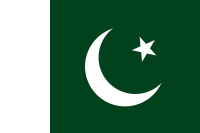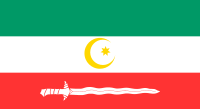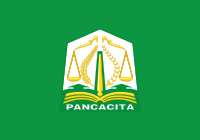Green in Islam

The color
Quran

Verses from the Qur'an describing reclining on green cushions and garments of fine silk imbue the color with a sense of tranquility and peace. Believers are adorned with green garments of fine silk and heavy brocade, symbolizing purity and divine favor.[2][3]
Reclining on green Cushions and rich Carpets of beauty
Upon them will be green garments of fine silk and heavy brocade, and they will be adorned with bracelets of silver; and their Lord will give to them to drink of a Water Pure and Holy.
The Green Dome, traditional site of the tomb of Muhammad, was painted green on the order of Sultan Abdul Hamid II (r. 1876–1909).[citation needed]
Islamic flags
Green flags were adopted by
Across the Islamic world, green finds expression in national flags, serving as a powerful symbol of faith and unity. From the flags of Saudi Arabia[12] and Pakistan to those of Algeria and Azerbaijan, green stands as a unifying mark, reflecting the shared heritage of Muslim nations.
Several more national flags as a symbol of Islam which include: Algeria, Azerbaijan, Comoros, Mauritania, Pakistan, Bangladesh, Saudi Arabia, Sri Lanka, and Tajikistan.[13][14] Some Arab countries also use pan-Arab colors, which include green. These include: Iraq, Jordan, Kuwait, Lebanon, Sudan, Syria, and the United Arab Emirates, as well as several contested states including Palestine, Somaliland, and Western Sahara. Libya formerly also followed this principle, featuring green as its only component color (at the time the only flag in the world to use only one color) until 2011.
There are also several flags of Muslim-majority countries featuring green color that does not symbolize Islam. Examples include
In Islam, the color green holds significant symbolism and is often associated with nature, life, and renewal. It is frequently referenced in religious texts and traditions, symbolizing paradise and the lush landscapes described in the Qur'an. Beyond its use in national flags of some Islamic countries, such as Saudi Arabia and Iran, green is widely utilized in Islamic art, architecture, and attire. Its prevalence in mosques, Qur'anic manuscripts, and decorative elements underscores its importance in Islamic culture and aesthetics.[1]
Green is a common color used by Islamist political parties.[15]
Gallery
-
Flag of Bangsamoro, Philippines
-
Flag of Aceh, Indonesia
See also
References
- ^ ISSN 0578-8072.
- ISSN 0570-5398.
- ISSN 0271-3519.
- ^ ibn Hāshim 2009, Sura 55.
- ^ ibn Hāshim 2009, Sura 76, The Human (Al-Insaan).
- ^ ibn Hāshim 2009, Sura 18, The Cave (Al-Kahf).
- ^ Catherine, David. "Al-Khidr, The Green Man". Retrieved 2007-11-30.
- OCLC 495469456.
- ISBN 978-0-88706-564-4.
- ISBN 978-0-7914-5883-9.
The Ismaili Shi'ite counter-caliphate founded by the Fatimids took white as its dynastic color, creating a visual contrast to the Abbasid enemy.
- ISBN 978-0-582-40525-7.
- ISSN 0271-3519.
- ^ "Field Listing :: Flag Description". The World Factbook. Central Intelligence Agency. Archived from the original on January 9, 2019. Retrieved 12 March 2019.
- ^ "Information about national flag of Tajikistan". www.advantour.com. Retrieved 2017-10-25.
- OCLC 60393965.
Bibliography
- ibn Hāshim, Abū al-Qāsim Muḥammad ibn ʿAbd Allāh ibn ʿAbd al-Muṭṭalib (2009), Quran The Final Testament, Khalifa, Rashad transl, Tucson: Majid, retrieved 2007-11-30
- Abdul-Matin, Ibrahim. “Green Deen: What Islam Teaches about Protecting the Planet.” Green Deen: What Islam Teaches about Protecting the Planet, Kube Publishing, 2012.




